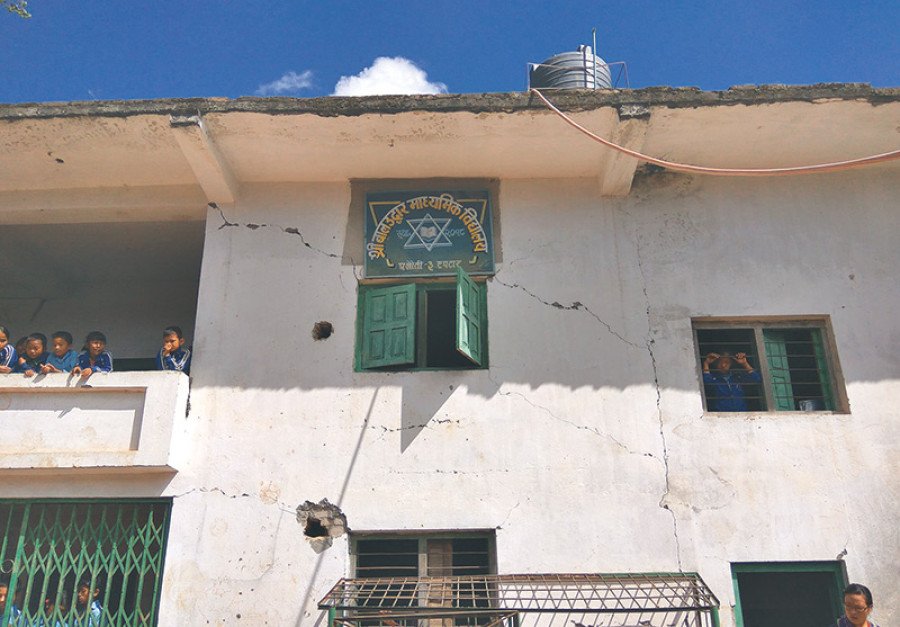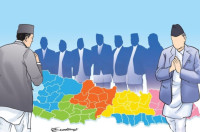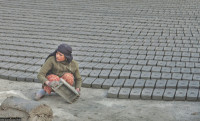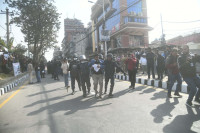Opinion
Playing with our future
Perhaps it is because public schools have been disproportionately affected by the quakes that the authorities’ response has been so slow
Deepak Thapa
The sellers of dreams are at it again. With election season on, politicians have begun promising the impossible. As an example, I cite a newspaper story from the day before yesterday that took up one of the major parties’ promise to raise the national per capita income to $5,000 within a decade, and calculated it would require a sustained growth rate of 19 percent per annum over the next 10 years for that to materialise—a feat that the Chinese have not been able to accomplish even once in the four decades since their economic miracle began. One does wonder at the kind of exercise policy wonks within the parties engage in to come up with such figures even though it seems pretty obvious that they adopt the expedient path of simply pulling them out of the hot air politics thrives in.
What is perhaps even more disconcerting is that we just passed the second anniversary of the major tragedy of the 2015 earthquake, and despite the obvious lack of progress in reconstruction, the focus of all the major parties has been solely on reaping the spoils of office. Since it is part of recent memory, there is no point recounting the hash our leaders made of the entire effort, starting with the sickening politicisation that stalled the setting up of the National Reconstruction Authority (NRA) for months. The numbers speak for themselves. Till date, only a total of 718 households out of the more than half a million with which the NRA has signed MoUs have received the third and final tranche of the rebuilding grant.
Plight of our kids
This article, however, is not about the national reconstruction effort but instead focuses on only one important aspect—schools, and the future of millions of students they embody. I presume readers remember how much was made of the fact that the first trembler struck on a Saturday, sparing the country an even greater tragedy of a higher number of school students killed or maimed. But, two years on, the situation has not changed for a huge number of students.
The accompanying photograph is of a school in Kavrepalanchowk that was quite badly damaged during the earthquake. The school building received a ‘red sticker’ from the technical team that examined it. In other words, the building has been determined not fit for use. But, as is quite clear, that is hardly a luxury either the school management or the students can afford.
No help has been forthcoming from the government so far. The District Education Office has expressed its inability to provide any assistance even though the district is among those covered by donor grants available for the reconstruction of schools. As
communicated to the school management, only schools with a certain amount of land qualify for the reconstruction grant, which, unfortunately, this school does not own. Caught in this conundrum are the students and teachers who have no choice but to carry on with this most holy of everyday interactions of imparting and receiving education in a building their own government has deemed unsafe.
According to the Post-Disaster Needs Assessment led by the National Planning Commission immediately after the earthquake, the country’s education sector suffered damages and losses estimated at Rs31 billion, with the 14 most affected districts accounting for 80 percent of those losses. It should also come as no surprise that 92 percent of this destruction was borne by public schools. One cannot but help think that perhaps because it is public schools that have been so disproportionately affected, the response from those in charge has been so tardy. Barring some exceptions, the children of everyone responsible, from planning to implementation, would certainly be attending the private-sector ‘boarding’ schools.The latest issue of the magazine dedicated to teachers, Shikshak, makes mind-bogglingly clear the mess we have in school reconstruction. For starters, according to Baikuntha Aryal, Joint Secretary at the Ministry of Education, in the last fiscal year, not a single rupee was allocated for school reconstruction in the 14 highly affected districts for the simple reason that it was assumed that the rebuilding of schools would be undertaken by the NRA. Aryal gives the startling figures that of the 7,923 school buildings destroyed or damaged, only 1,662 have been reconstructed so far—600 by the government and the rest by the non-government sector.
Aryal further says that we require an estimated Rs167 billion for reconstruction in the school sector. The Asian Development Bank and JICA, Japanese aid agency, along with the Indian Embassy have committed a total of Rs40 billion for the reconstruction of 828. The government has no plans on how to help the remaining 7,000+ schools.
Aryal blames the usual factors for this state of affairs, including the ever-present lack of coordination. The funds promised by Saudi Arabia for school reconstruction have not been accessed for precisely this reason. Likewise, the process for any organisation to receive permission to reconstruct schools has been made so long and cumbersome that it takes up to six month for the go-ahead to materialise.
Six months for NGOs to receive permission appears to be news to the current NRA chief, Govinda Raj Pokharel. He says that he found out that it takes nine months for his office to provide permission to NGOs to rebuild schools. Six months or nine months, the time period is immaterial for the thousands forced to continue their education under extremely dangerous conditions.
It does not help that there are also those who just sit on the agreements, such as the Nepal Chamber of Commerce, which signed on to reconstruct 150 schools. But a year and half on, not a single brick has been laid. In the case of at least one school in Kathmandu, even geopolitics appears to have played a part in the delay. The iconic Padmodaya High School in Kathmandu’s PutaliSadak was provided assurances of help by a Taiwanese organisation but, as it turned out, the Ministry of Education rescinded its previously granted permission under pressure from the Chinese Embassy.
Misplaced priorities
What of the dream-selling politicians? Their attention has partly been diverted by the impeachment motion against the Chief Justice of the Supreme Court. But, overall, their entire focus is on the upcoming local level elections. Their manifestoes are replete with references to the earthquake and the myriad promises to do this, that and the other. Given their past record, these words would hardly sound endearing to the affected population, and one can only hope that with local bodies in place, there will be much better accounting of the reconstruction efforts even though it will be months before any results will be visible.
In the meantime, there is no one to look out for the school students in the 14 districts as they brace for yet another monsoon. The one group that should have spoken out, the student wings of political parties, have set their sights on the private sector education providers. What a change it would have been if instead of locking up private schools in a never-ending battle, they were to take up cudgels against the NRA or the Ministry of Education, and demand the immediate reconstruction of schools in Nepal’s hinterlands. That probably would have been the case had they not been politicians masquerading as students.




 9.12°C Kathmandu
9.12°C Kathmandu










